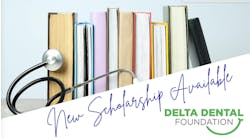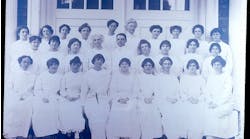by Patti A. Sooy
We are inundated on television with a new reality show every time we turn around - Survivor, Average Joe, Fear Factor, The Bachelor, The Apprentice, and the list goes on. Reality is defined as the quality or state of being actual or true and that which exists objectively and in fact. So how does the practice of dental hygiene compare to how we were taught and what we actually do for our patients in the real world? Do we compare to the shows on television where we sell out others to benefit ourselves? Or do we go the extra mile and play as a real team to give our patients the best care possible? So how about playing a little game of Reality Hygiene - Remember When?
Remember the days of hygiene school when the first real patient you ever saw took the entire 3 hours just for a screening? This included a very thorough health history, gathering every specific detail about past surgeries (hemorrhoids included) and hospitalizations; looking up every medication (prescription and over-the-counter) in the PDR, and then writing every contraindication and drug interaction possible. We took blood pressure, pulse, and, in my day, temperatures on every patient.
A head and neck exam was completed next. Every mole, nodule, scar, skin discoloration, asymmetry, and palpable lymph node was noted, including the size, shape, location, duration, and tolerance by the patient. The extra-oral exam alone could take up to 35 minutes. Then we moved inside the mouth. Everything seemed abnormal to new students the first few times we saw it. We'd write down existing fordyce spots, linea alba, sublingual caruncles, palatine torus, and enlarged uvulas to name a few. Everything was documented because it created a roadmap for future visits. What had changed, and what had remained the same?
Next, we took radiographs. Almost every patient received a full mouth set of X-rays if it had been five years or more. Each X-ray was critiqued for diagnostic quality - no cone-cuts, did the bitewings have open contacts, could you see the distals of second molars or heaven forbid, third molars? Was there a minimum of 2mm of bone showing around each apex on all periapicals (and, yes, some instructors actually got out the probes to check this)? If not, you took them again.
Dental charting was completed and included missing teeth, existing restorations, diastemas, torso-version, supernumary teeth, impactions and linguo-verted or bucco-verted teeth. We checked occlusion for classification, cross-bites, balancing interference and canine rise and then filled out the appropriate referral slips. And finally we picked up a probe - six readings per tooth, bleeding points, furcation involvement, mobility, suppuration, gum texture, recession, and classification. No wonder it took 3 hours. All of this was, of course, checked again by an instructor and then by the dentist. These patients received outstanding diagnostic care. No stone was left unturned, no class five restoration left uncharted. Then they had to return for the cleaning which could take up to four visits just for a Class I or II patient.
So what happened to this type of examination? We graduated and went to our first job where we had only 40 minutes to see adult patients. Reality hygiene strikes; welcome to the real world of dental hygiene.
Hygienists have been so busy scraping, polishing, spot probing and charging out adult prophies that we've forgotten what complete care is for our patients. When was the last time one of your patients received a complete head and neck exam or a full periodontal charting including bleeding points, furcations, recession, and mobility that is completely documented for future comparison?
When was the last time you had a discussion with your patient about the oral infection that may be contributing to their systemic ill-health? Or how often do we accept 4-5mm pockets with generalized bleeding as normal and treat with an adult prophylaxis instead of periodontal therapy? I know that in medicine when a patient has a stomach ulcer (compare it to a pocket), it's considered an infection and the doctor advises some type of treatment. When the ulcer is bleeding, it may necessitate surgery. Shouldn't we be doing the same for our dental patients?
I know what you're thinking: How? We don't have enough time right now to do the basics.
Well, I am in total agreement. We don't have enough time. We all lose when we don't have enough time to complete these diagnostic tasks, especially our patients. Your bottom-line production is seriously impacted because there isn't enough time to diagnose disease and enroll patients into the disease-control therapy that they deserve. Individually, hygienists get burned out and frustrated doing 40 minute cleanings all day long. You are not able to use all the skills you are licensed to use that you worked hard to perfect in school.
The solution is easier than we think. Here is the true reality. A comprehensive examination and adult cleaning can be accomplished in a 60-minute appointment. Thankfully, we are much faster than we were initially in school. We recognize abnormalities quickly, but we must take the time to actually screen and educate our patients if something abnormal is noticed. A complete head and neck with an intraoral cancer screening exam should take about three minutes. That three minutes could save a life if you spot something in the early stages and educate your patient to get a medical exam.
Radiographs and periodontal charting can be alternated on a yearly basis, so you are not completing both at the same appointment. The first 20 to 25 minutes of a 60-minute appointment should be spent gathering information. The next 15 to 20 minutes should be spent on scaling and polishing (if you are spending more time than this, then you may be doing more than a prophy; either they need periodontal therapy or a more frequent recare interval). And the last five to 10 minutes should be set aside for the doctor's exam and room turnover.
You'll be amazed at how much better you feel when you give complete care to your patients. You'll no longer feel like a "Survivor" at the end of the day; instead, you'll have a sense of accomplishment and fulfillment. You won't have the "Fear Factor" each morning hoping you can keep up with the hectic schedule. You'll be more productive as a hygienist, so you won't hear the words "You're fired" from your boss. And, most of all, you're patients will consider you a remarkable hygienist that gives outstanding care. Isn't that much more rewarding than being just an "Average Joe?"
Patti A. Sooy, RDH, BS, has been a practicing hygienist for more than 20 years in Washington State. She is the founder of Dynamic Hygiene, a hygiene counseling group, and co-owns Hi-Tech Hygiene, a company dedicated to the integration of soft-tissue lasers into the hygiene schedule. Patti is a speaker, consultant, author, and expert in the business of dental hygiene. She continues to work in private practice as a soft tissue specialist, restorative provider, and business manager. She can be contacted at (509) 235-4042 or [email protected].





